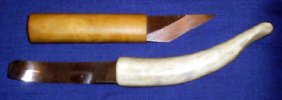- Joined
- Jun 4, 2002
- Messages
- 3,930
I like to do a bit of woodcarving and leatherwork. Two very traditional knives used for such endeavors are a skew knife and a crooked knife. Can't make a proper crooked knife until I get access to a forge, but the skew knife was no problem. When I think traditional knives I am absolutely unbiased, so when I stumbled across what the Japanese call a "Kiridashi", I said "bingo, that's a skew knife in it's simplest form". I've attached a pic of one from the japanesetools.com website (keep your fingers crossed that it works). The one I made turned out really, really, nice. It's chisel ground (bevel on one side only) at a fairly acute angle, and the dang thing cuts wood or leather like it was cheese. For the handle I used my favorite handle wood, boxwood (it was very commonly used for knife handles during the middle ages),and for the saya (scabbard) I used basswood with a wrap of silk thread at the throat.
Why am I going on about this odd little knife? Because it would be a very simple knife for a first time knifemaker to try his hand at. A six inch metal cutting file is perfect for the blade, and since the blade is so much like a chisel you've got some nice unsharpened flats for use as a chakma on your khuks. Not a bad deal for a "custom" knife that'll cut figure eights in harness leather, and can be made for about five bucks in materials, in roughly two hours.

Sarge
Why am I going on about this odd little knife? Because it would be a very simple knife for a first time knifemaker to try his hand at. A six inch metal cutting file is perfect for the blade, and since the blade is so much like a chisel you've got some nice unsharpened flats for use as a chakma on your khuks. Not a bad deal for a "custom" knife that'll cut figure eights in harness leather, and can be made for about five bucks in materials, in roughly two hours.

Sarge

